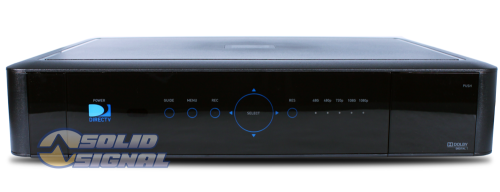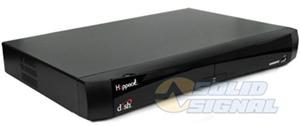Clients rule the world. At least, they rule the world of satellite. Since 2012, the leaders in satellite TV have both used clients instead of receivers in their top-end devices. That means for the last six years, pretty much every new customer has gotten a server-client system instead of a receiver-based system. But, what does this mean? Let’s take a deeper look.

Few people expected that this box from DIRECTV would rock the world. Originally called by the boring name of “HR34” it quickly became renamed as “Genie.” It became the basis for all DIRECTV installations after it, as it begat the HR44 and HR54 Genies, as well as the Genie 2.

On the DISH side of the street, we saw the Hopper come out not long after the original HR34. Like the HR34 it spawned a whole new generation of hardware, although we didn’t realize at first how important it would be.
Both DISH and DIRECTV came up with their “super DVRs” as we called them, in order to address a need. When DVRs first hit the scene in the mid-2000s, people bought one. And then, they got addicted. They didn’t just want to pause live TV in the living room, they wanted to pause in the bedroom, pause in the kitchen, pause in the guest room. So people started getting more than one DVR. This created problems.
First problem was trying to figure out a good scheme where you could watch a program on one DVR from another. DIRECTV cracked this fairly early but DISH really didn’t, not on the same scale. The bigger problem, though, was those early DVRs were given to customers at a loss. In other words the customer paid $199 for them but they cost as much as $600 to build. DIRECTV and DISH could absorb the cost of one DVR in the home, but not ten.
So, they developed the “client-server” model. The idea was, you’d have one super-powered DVR in one room. In the other room you would have devices that acted like DVRs, but wouldn’t. It’s actually cool how you do this.
MoCA is a technology that really made this dream possible. It’s a way to put network information on a coax cable that’s really, really good for TV watching. Just putting ethernet over coax is easy. In fact a lot of early Ethernet systems were on coax. The problem was that most forms of computer networking focus on an error-proof stream, not a smooth one. If your computer doesn’t get data when it asks for it, it just keeps asking. Think of how web pages load. Sometimes the computer just sits there. That’s no good for TV. You expect TV to be 100% live, with minimal skips or gaps.
By using MoCA, you can send video information over a cable and it works the way you want it to. If there’s an error, the system just moves on. You might not notice it or it may seem like a quick freeze or blip. You would never have a long pause where video just freezes.
Both DIRECTV and DISH took the idea of MoCA and supercharged it. The Genie and Hopper systems do almost 100% of the work at the DVR. All the video is captured there, all the recordings are stored, and when someone wants to watch in another room, everything including the information screens, is generated by the DVR. It’s sent using MoCA to the other boxes. All they have to do is translate that video to HDMI for output and respond to remote commands.
In this way, a client box can be very small, very quiet, and most importantly, very cheap to make. That’s the goal, and it works spectacularly.
A client box like DISH’s Joey or DIRECTV’s Gemini looks like a small receiver. It acts like one, too, and that’s the point. However, a receiver is a lot more complex. It actually decodes the satellite signal on its own. It’s a totally standalone thing and that means it uses more power and costs more to make.
Generally speaking a receiver cannot pause live TV but a client (because it gets all its video from the DVR) can. That’s the biggest difference to regular customers. The other thing that RV users have noticed is that a receiver will work by itself in an RV, where if you take a client box from home it won’t do anything.
Both DIRECTV and DISH want you to not even think about whether something is a receiver or a client. They just want you to think about the fact that it works. That’s the bottom line. Client boxes work great. Receivers work great. Hopefully, your whole satellite system works great.
If you’re ready to update your DIRECTV or DISH system, call the experts! Solid Signal is a DIRECTV residential dealer and a DISH Premier Local Retailer. We’re here to take care of you! We can offer you the same products and deals as DIRECTV and DISH, and we’re here to provide you excellent customer service.
Call us at 888-233-7563 during East Coast business hours or fill out the form below and get started!
The post How is a DIRECTV (or DISH) client different from a receiver? appeared first on The Solid Signal Blog.
Continue reading...
First, a little history.

Few people expected that this box from DIRECTV would rock the world. Originally called by the boring name of “HR34” it quickly became renamed as “Genie.” It became the basis for all DIRECTV installations after it, as it begat the HR44 and HR54 Genies, as well as the Genie 2.

On the DISH side of the street, we saw the Hopper come out not long after the original HR34. Like the HR34 it spawned a whole new generation of hardware, although we didn’t realize at first how important it would be.
There’s just one problem (or maybe two.)
Both DISH and DIRECTV came up with their “super DVRs” as we called them, in order to address a need. When DVRs first hit the scene in the mid-2000s, people bought one. And then, they got addicted. They didn’t just want to pause live TV in the living room, they wanted to pause in the bedroom, pause in the kitchen, pause in the guest room. So people started getting more than one DVR. This created problems.
First problem was trying to figure out a good scheme where you could watch a program on one DVR from another. DIRECTV cracked this fairly early but DISH really didn’t, not on the same scale. The bigger problem, though, was those early DVRs were given to customers at a loss. In other words the customer paid $199 for them but they cost as much as $600 to build. DIRECTV and DISH could absorb the cost of one DVR in the home, but not ten.
So, they developed the “client-server” model. The idea was, you’d have one super-powered DVR in one room. In the other room you would have devices that acted like DVRs, but wouldn’t. It’s actually cool how you do this.
MoCA for everyone
MoCA is a technology that really made this dream possible. It’s a way to put network information on a coax cable that’s really, really good for TV watching. Just putting ethernet over coax is easy. In fact a lot of early Ethernet systems were on coax. The problem was that most forms of computer networking focus on an error-proof stream, not a smooth one. If your computer doesn’t get data when it asks for it, it just keeps asking. Think of how web pages load. Sometimes the computer just sits there. That’s no good for TV. You expect TV to be 100% live, with minimal skips or gaps.
By using MoCA, you can send video information over a cable and it works the way you want it to. If there’s an error, the system just moves on. You might not notice it or it may seem like a quick freeze or blip. You would never have a long pause where video just freezes.
Both DIRECTV and DISH took the idea of MoCA and supercharged it. The Genie and Hopper systems do almost 100% of the work at the DVR. All the video is captured there, all the recordings are stored, and when someone wants to watch in another room, everything including the information screens, is generated by the DVR. It’s sent using MoCA to the other boxes. All they have to do is translate that video to HDMI for output and respond to remote commands.
In this way, a client box can be very small, very quiet, and most importantly, very cheap to make. That’s the goal, and it works spectacularly.
Client vs. receiver
A client box like DISH’s Joey or DIRECTV’s Gemini looks like a small receiver. It acts like one, too, and that’s the point. However, a receiver is a lot more complex. It actually decodes the satellite signal on its own. It’s a totally standalone thing and that means it uses more power and costs more to make.
Generally speaking a receiver cannot pause live TV but a client (because it gets all its video from the DVR) can. That’s the biggest difference to regular customers. The other thing that RV users have noticed is that a receiver will work by itself in an RV, where if you take a client box from home it won’t do anything.
Both DIRECTV and DISH want you to not even think about whether something is a receiver or a client. They just want you to think about the fact that it works. That’s the bottom line. Client boxes work great. Receivers work great. Hopefully, your whole satellite system works great.
If you’re ready to update your DIRECTV or DISH system, call the experts! Solid Signal is a DIRECTV residential dealer and a DISH Premier Local Retailer. We’re here to take care of you! We can offer you the same products and deals as DIRECTV and DISH, and we’re here to provide you excellent customer service.
Call us at 888-233-7563 during East Coast business hours or fill out the form below and get started!
The post How is a DIRECTV (or DISH) client different from a receiver? appeared first on The Solid Signal Blog.
Continue reading...

